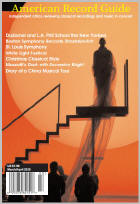Texte paru dans: / Appeared in:
Alpha |
|
|
Outil de traduction ~ (Très approximatif) |
|
|
Reviewer: Michelle
Thompson
Once upon a time, there were
two approaches to performing a piece of music. One involved playing (or
singing) the notes on the page as you were taught; the other involved
investigating how such things might have been done when the music was
written, and then doing that. These were called “music” and
“historically-informed performance”. I kid, I kid. But my fairy tale has a
lot to do with the Monteverdi Vespers. This is a piece that basically had no
modern performance history at all before the historical-performance revival;
for that matter, it would seem to have no contemporaneous performance
history either. That it was presented to the Pope (as second fiddle to a
six-voice Mass) we know; that it was ever performed, in whole or in part, we
don’t. It was practically a performance-practice industry unto itself for a
while. Are the “concerti” interspersed between the Psalms antiphon
substitutes? Does the inclusion of ‘Duo Seraphim’ (a text in praise of the
Trinity) link it to Mantua and to St Barbara, martyred for her belief in the
Trinity? Does the use of “chiavette” (a collection of high clefs) in ‘Lauda,
Jerusalem’ and the Magnificat mean that these movements should be
transposed down? And from where? Most of this has now been sorted out. Yes,
the concertos are antiphon substitutes, in a practice sufficiently common to
have been condemned by Rome. Yes, the chiavettes mean that you transpose
down, though that still leaves unresolved where you start. (Venetian pitch
was something like A465, Roman something like A390. That’s a full step up or
down, from modern pitch.) In short, we now have something like a way towards
listening to the 1610 Vespro more or less as they were. But what if someone
doesn’t want to leave things there? Ladies and gentlemen, I give you
Simon-Pierre Bestion. Bestion’s aim appears to be to use the Vespers as a
starting point for a more expansive “experience of the sacred” (my words,
not his). To that end, he tweaks Monteverdi’s text in all manner of ways,
from the minor to the profound. The most striking of these is probably his
decision to present all the Psalm texts twice—first in fauxbordon (a way of
“chordalizing” a simple plainchant like a Psalm tone), then more or less as
Monteverdi set it. The idea likely stems from the opening ‘Deus in
adjutorium’, where the composer does it himself, laying the short sung text
atop the toccata that opens his then-recent opera Orfeo. Here we get just
the text in bare faux-bourdon, then the toccata, then both together. But
Bestion does the same for each Psalm setting: a chant antiphon, then the
Psalm text in faux-bourdon, then Monteverdi’s setting. Not only that, but
there appear to be two choirs involved, or at any rate two wildly different
styles of singing, with the faux-bourdon rough, nasal, and raucous, and the
composed setting much more like the usual early-music chamber choir sound.
(But it doesn’t seem to be sung in Frenchified Latin, despite the nearly
all-French performing forces.) The antiphons themselves are sung by an
“androgynous” (Bestion’s word) solo voice; they are heavily ornamented in a
vaguely Middle-Eastern style and sometimes accompanied by one or more sung
drones. The effect, intended or not, is to jerk the listener abruptly from
one musical milieu to another. Something similar goes on with the
instrumental parts, which Bestion has freely—nay, extravagantly—recomposed
to his own satisfaction. There’s a thunderous glissando in the continuo
here, a glitter of high triple harp there, much bustle of extra viola and
viol parts nearly everywhere. Once or twice these additions are startling in
a good way; I actually rather like the pizzicato opening of Laetatus sum,
though when it’s joined by a serpent (to Bestion this recalls the Jewish
shofar—he doesn’t actually mention the Venetian ghetto, but you just know
his mind is leaning that way) and the usual bevy of scurrying viol
figuration, it gets old pretty rapidly.
You get the idea. Bestion’s
Vespers is a sort of rag-bag of “the numinous” as rendered in early 17th
Century Europe and environs— a role far too big for the actual work of music
he attaches it to, vast though that is. The depressing part is that there’s
about two-thirds of a perfectly fine Monteverdi Vespers in this performance,
if one is minded to dig around for it. Most of the concertos are finely
sung, for example; so are parts of the Psalms and the Magnificat, and even
the Sonata sopra Sancta Maria (where Bestion, confronted with a lot of
fully-written-out instrumental parts and one vocal line, can’t actually do
all that much). But the whole project, to put it as charitably as possible,
is more thought-experiment than performance. Stick with Masaaki Suzuki on
BIS for an excellent, basic
chamber-sized performance (with the Mass thrown in!), or Jordi Savall on
Alia Vox for a slightly more idiosyncratic one, with exceptional
instrumental playing and a more Mediterranean approach. | |
|
|
|
|
Cliquez l'un ou l'autre
bouton pour découvrir bien d'autres critiques de CD |
|




